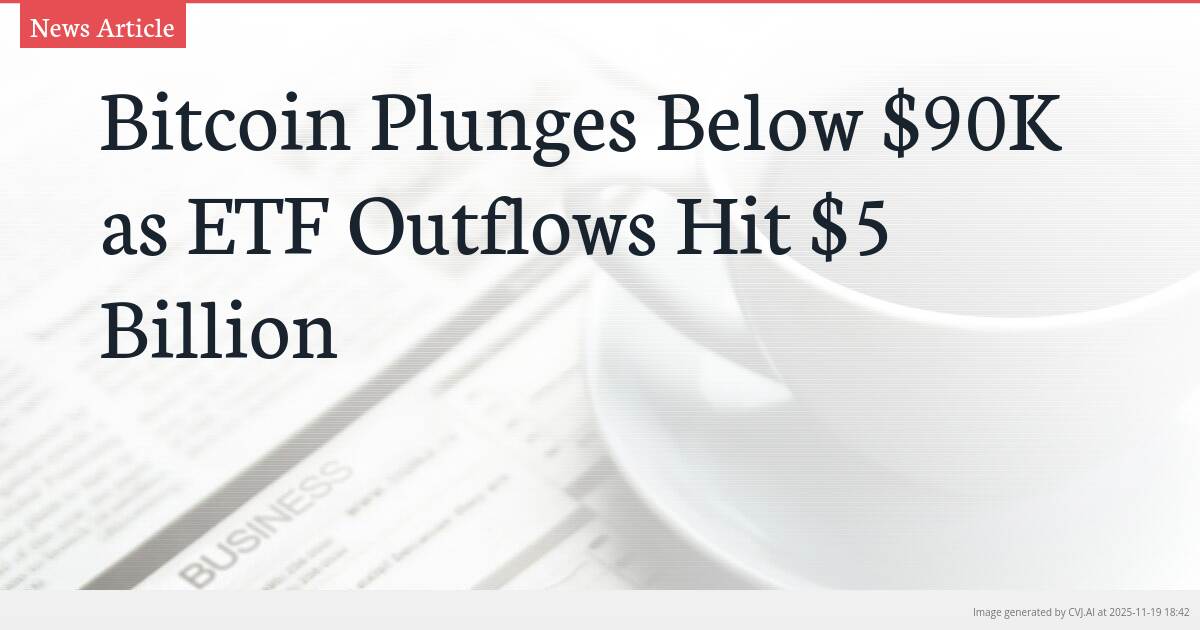Introduction
Bitcoin’s recovery attempt to $94,000 proved fleeting as the cryptocurrency tumbled back below $90,000 amid massive ETF outflows. BlackRock’s IBIT has suffered $2.65 billion in withdrawals over 15 trading days, setting record single-day outflows. The broader spot Bitcoin ETF market has seen nearly $5 billion exit since late October, dragging prices down from recent highs above $116,000 and signaling a dramatic reversal from summer rally momentum.
Key Points
- BlackRock's IBIT recorded $523.2 million in outflows on November 18 – the largest single-day withdrawal in its history
- Total outflows from US spot Bitcoin ETFs have reached nearly $5 billion since October 29, reversing summer rally momentum
- Ethereum ETFs have seen net outflows in 22 of the last 28 trading days, mirroring Bitcoin's ETF-driven price decline
Record ETF Outflows Fuel Bitcoin's Decline
The recent volatility in Bitcoin’s price directly correlates with unprecedented outflows from spot Bitcoin ETFs in the United States. Since October 29, nearly $5 billion has been withdrawn from these funds, creating substantial selling pressure on the underlying asset. This massive capital flight represents a stark reversal from the summer months when these same ETFs were attracting millions, and sometimes billions, of dollars daily during the market rally.
BlackRock’s IBIT, the world’s largest BTC-focused ETF, has been at the epicenter of this exodus. Data reveals that IBIT has experienced net outflows in 11 out of the last 15 trading days, with only two days showing positive numbers during this period. The fund has lost approximately $2.65 billion within this timeframe, with November 18 marking a particularly grim milestone: a record single-day outflow of $523.2 million. This pattern of sustained withdrawals has fundamentally altered market dynamics, shifting from accumulation to distribution.
Fidelity’s FBTC has mirrored this troubling trend, contributing significantly to the overall outflow figures. Notable examples include outflows of $356.6 million on November 4 and $256.7 million on November 7. The coordinated nature of these withdrawals across multiple major funds indicates a broader shift in institutional sentiment rather than isolated fund-specific issues, creating a powerful headwind for Bitcoin’s price recovery efforts.
Price Impact and Market Consequences
The correlation between ETF outflows and Bitcoin’s price decline is unmistakable. BTCUSD traded above $116,000 at the end of October before the outflow cycle began, but has since dropped by more than $26,000 to trade well below $90,000. The most recent rejection at $94,000 earlier today demonstrates the ongoing selling pressure that continues to cap any meaningful recovery attempts. This represents a significant correction that has erased months of gains and tested investor confidence.
The situation extends beyond Bitcoin to the broader cryptocurrency market, with Ethereum facing even more severe pressure. Ethereum ETFs have been experiencing consistent outflows since October 8, with only six out of the 28 trading days since that date recording net inflows. The remaining 22 days have all seen negative flows, creating sustained selling pressure that has driven ETH’s price from nearly $4,800 on October 7 to below $3,000 in recent trading.
This synchronized decline across major cryptocurrencies suggests a systemic shift in investor behavior rather than asset-specific concerns. The fact that both Bitcoin and Ethereum ETFs are experiencing similar outflow patterns indicates that the current market correction is driven by broader macroeconomic factors or sector-wide risk reassessment rather than issues unique to either cryptocurrency.
Broader Market Implications
The current ETF outflow situation represents a dramatic reversal from the optimistic summer months when institutional adoption appeared to be accelerating. The shift from consistent inflows to sustained outflows suggests that the initial euphoria surrounding spot Bitcoin ETF approvals has given way to more cautious, risk-off positioning among institutional investors. This change in sentiment could have lasting implications for cryptocurrency market structure and institutional participation levels.
The record-setting nature of the November 18 outflow from IBIT, combined with the consistent negative flows across multiple funds, creates a challenging environment for price stabilization. With nearly $5 billion exiting the spot Bitcoin ETF ecosystem in just over three weeks, the market must absorb significant selling pressure that shows few signs of abating. This sustained capital flight raises questions about the durability of institutional cryptocurrency adoption and the market’s ability to recover from such substantial outflows.
For traders and investors, the current environment underscores the importance of monitoring ETF flow data as a leading indicator of price direction. The correlation between outflow spikes and price declines has become increasingly evident, making these metrics crucial for understanding short-to-medium-term market movements. As the cryptocurrency market continues to mature, the influence of institutional vehicles like ETFs on price discovery and volatility patterns appears to be growing more pronounced.
📎 Source reference: cryptopotato.com

